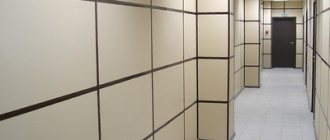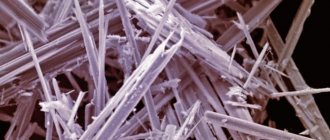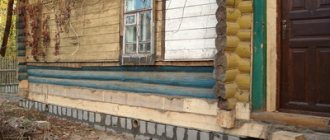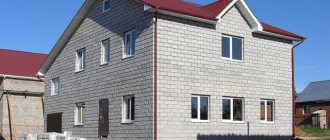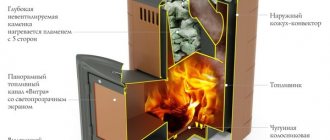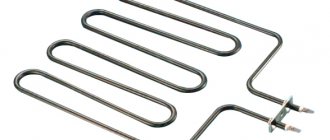According to fire safety rules, the arrangement around stoves, fireplaces and fuel boilers must be done using fire-resistant special materials, which can simultaneously protect a residential or ancillary building (bathhouse) from possible fire hitting the walls, and at the same time not cause harm to health.
To create a favorable home atmosphere, any stove or fireplace becomes very hot and generates intense heat, which in turn can be a source of ignition or fire. Therefore, it is important to carefully select the right materials when arranging a heat source in a house, bathhouse or basement, if we are talking about a fuel boiler.
Fire resistance of building materials
Facing materials differ in chemical composition, structure, thermal insulation, and hygroscopic properties. Depending on the raw materials from which they are made, the following materials are distinguished:
- organic;
- inorganic;
- mixed.
Non-flammable (NG) are inorganic materials: stone, brick, glass, asbestos cement and others. When organic and polymeric substances are added, the properties of the product change. NG include:
- inorganic materials permitted in construction;
- metals;
- gypsum boards containing 8% organic matter;
- mineral wool boards - 6% binder components.
Refractory materials contain 8–15% filler. All other organic materials are considered flammable.
Characteristics of stove varnish
Fireplace (or stove) varnish is most often made from silicone resin diluted in a solvent. Special additives are also added to paintwork materials. The varnish has a specific smell and transparency.
However, coloring agents can be added to paintwork materials, which will give the treated surface the desired shade.
Typically the paint composition is applied in two layers. The consumption of the substance can vary greatly, depending on the porosity of the material being processed. Each layer dries from 30 minutes to an hour at a room temperature of 18 to 25 degrees.
It is not by chance that varnish is called heat-resistant - it is able to maintain its qualities at extreme temperatures - from 200 to 250 degrees. Is it possible to varnish porcelain tiles on the floor video? There are also more thermally stable coatings, for example, aluminosilicone.
Such paints and varnishes are able to retain their qualities even at a temperature of five hundred degrees.
Choose a varnish based on your needs, consult with specialists
In addition to thermal resistance, stove varnish is characterized by other positive properties:
- resistance to high humidity and its consequences in the form of efflorescence, mold and fungi;
- protection against aggressive chemicals (solutions containing salt, petroleum products, technical oils, etc., which even after contact with the stove surface cannot be absorbed by it);
- such paintwork materials can be used not only indoors, but also outdoors;
- heat-resistant paintwork dries quickly, so you can add alkyd or acrylic varnish to it;
- high level of adhesion, which allows the composition to penetrate deeply into the material, providing it with a high level of protection;
- surfaces treated with this varnish are aesthetically pleasing to the eye, distinguished by a beautiful shine and fullness of shades.
Furnace lining materials
Lining is the lining of the furnace surface that is in contact with the flame. But since, in addition to protection, it can reduce heating efficiency, it is important to calculate the thickness of the layer.
Heat-resistant materials are installed during the construction of the stove or during its finishing.
Examples of furnace lining Source yandex.net
Lining material:
- fireclay products;
- leaf kaolins;
- mullite mats;
- basalt wool;
- vermiculites;
- fire-resistant compounds.
The same applies to cast iron stoves - they get very hot, so the walls near them must be protected, especially if the stove is installed in a wooden house.
Conclusion
Thermal insulation materials for stoves are an important component of the stove itself, without which it will not be possible to properly arrange the work.
Also, it is worth adding that it is very important to choose the right material, install it firmly and not overpay a lot of money for it. Fortunately, there are now a huge number of materials and by studying them, you can understand for yourself which one will suit your stove or wall.
Fireproof decorative panels for stoves can not only protect you, but also complement your interior. Experts say that choosing insulating material should be like choosing wallpaper. Sheets, panels or slabs must fit correctly into the overall picture of the room, especially if we are talking about a stove inside the house.
Very often, fireclay slabs for stoves can brighten up your simple interior in the house and add some zest to it.
Heat-resistant insulation for furnaces is not a luxury, it is a necessity. You could even say that this is an important element of the stove, which you cannot do without. When equipping your stove, do not forget to immediately make a list of the necessary materials for thermal insulation of the surface around the stove.
Wall and ceiling cladding near heating units
Safe distances for factory furnaces are indicated in the passport. Based on these data, a protective screen is made behind the stove. For installation, use basalt insulating cardboard. This fire-resistant material for finishing walls under a stove is easy to cut and bend, and does not emit harmful substances in the event of a fire. Sheets of basalt fiber are installed end-to-end with the reflective part inside the room.
Important! A gap of 5–10 cm is left between the ceiling and the screen for shrinkage of the house.
The screen should protrude 20–30 cm to the left and right of the stove. The protective casing is made of fireclay and red stove material 0.5–0.25 bricks thick. The floor near the stove is covered with a sheet of stainless steel, galvanized or porcelain stoneware.
The stove firebox is located low to the floor. In this case, it is protected with ceramic tiles.
The protective gasket should protrude 100 mm beyond the perimeter of the heating unit. Floor stainless steel sheets 600x800 mm cost 1,200 rubles.
A metal sheet is laid if the stove has a high base Source its-sauna.ru
Before lining the furnace, the following work is carried out:
- They build a base 170x70x145 cm. The first layer (15 cm) in the foundation is sand, the second 20 cm is stones, the third 10 cm is crushed stone. The foundation for the stove should be 20 cm below the finished floor.
- Brick, heat-insulating material, and a sheet of metal are laid on the base.
- Ceramic tiles are laid on the finished floor.
- Install the stove.
- Construct a fence of bricks.
Heating efficiency and home safety also depend on proper installation. Heat-resistant materials are used for the chimney: brick, stainless steel, asbestos-cement, ceramic, sandwich pipes.
Before installing the pipe in the ceiling, a square of 1.0 x 1.0 m is cut out. The inside is sheathed with mineralite sheets. The pipe is protected with a box if it runs next to joists and rafters. The inside of the protective frame is also lined with mineralite slabs.
See also: Catalog of companies that specialize in the installation of fireplaces and stoves.
Care Tips
In houses with stove heating, maintaining the stove and fences that protect the combustible structures of the house from overheating in good condition is the key to trouble-free living for its owners. Fire is no joke, and there are no trifles in observing fire safety rules! If they say that a sheet of metal measuring 500x700 mm is needed in front of the furnace loading door, it should be there!
Every year, before the start of the heating season, you should check the condition of the heating appliances at home. It is necessary to check whether the heat-resistant plaster of the stove is damaged, whether there are cracks in the chimney, or whether the facing tiles have fallen off. All identified defects must be corrected in a timely manner.
Fire-resistant panels are an excellent guarantee of the safety of your property.
Thermal insulation boards PIRRO
The Russian company PirroGroup produces non-combustible materials for finishing walls and ceilings. Thermal insulation boards based on polyisocyanurate foam have a closed cell structure that is filled with gas. The material does not support combustion due to its special design and composition.
Comparison of thermal conductivity indicators of Pirro fire-resistant board and other materials Source e-uteplitel.ru
PIR-boards PirroThermo are designed for insulation of walls and ceilings in baths. The thermal insulation material is lined on both sides with aluminum foil. Flammability class of panels G1-G2. PirroUniversal has a double-sided aluminum cladding. Price: 432 RUR/piece.
To protect the house, materials are used that have different characteristics and composition. We list the heat-resistant products that are used indoors:
- Drywall sheet.
- Terracotta tiles.
- Basalt fiber panels.
- Roll materials.
Protective screens
Protective fireproof screens are special fire-resistant decorative panels designed to insulate the side walls of furnace structures; they are mounted at a distance of 1-5 cm from the furnace body. The screen differs from a fire-resistant sheet in its multi-layer structure.
By using such heat-resistant insulation material, you can significantly reduce thermal radiation. Screens made of cast iron and stainless steel are widely popular.
The polished mirror surface of the steel screen reflects heat, which is characterized by softer flows. The plates located inside the screen are connected using heat-resistant mastic, mortar adhesive, and sealant, which are characterized by high heat resistance.
Heat-resistant mastic has a fire-resistant composition that can withstand high temperatures - 1100°C or more. In addition, it is not afraid of moisture, has bactericidal properties, and can be used as a cladding.
On the market you can find not only side screens, but also front ones. Installation of such devices is carried out by attaching them to the floor near the stove; the screen itself is equipped with special legs. In addition to steel and cast iron screens, quite often users also give preference to brick structures that look like walls. They separate the furnace body from flammable areas.
Protective screen
Fireplace cladding
Fireplaces are lined with stone, fireclay, marble, ceramic tiles and other non-combustible materials. When decorating a fireplace with natural stone, an additional foundation is made.
To decorate fireplaces, they use natural stone soapstone, which can withstand loads and is heat-intensive. Plates made from this material:
- protect stoves, fireplaces, chimney ducts;
- lining the walls and floor of the bathhouse;
- They make heated floors and walls with electric cables.
The stone was first mined in Finland. Talkomagnesite can withstand heating and cooling without losing its shape or color. Lining the stove with stone creates a healthy microclimate in the room and saves fuel. The technology for lining stoves came from Finland.
Price of the stone: 8000 rubles (sq. meter).
Thermal boxes for fireplaces are assembled and adjusted in production. Various shades of marble are used for installation. The protective casing is made according to individual projects, and ready-made claddings can be selected on the manufacturers’ websites.
Alternative finishing methods
A possible option for covering is felt, which is pre-impregnated with clay. You need to attach a sheet of tin close to the top for thermal protection. The modern wide range allows you to choose other options:
- Cover with flat slate, decorate with patterns
- Plaster and whitewash
- Lay tiles
For reference! The stove can be lined with stone, vermiculite, soapstone or terracotta.
Is it possible to cover the stove with plasterboard? It will burn, reduce heat transfer and simply crumble over time. An alternative is special refractory clay (or mortar). The finished surface can be additionally covered with porcelain stoneware.
How to prepare gypsum mortar for finishing a brick oven:
- Knead the clay in water (1:3).
- Wait until completely dissolved and mix thoroughly.
- Pour the solution into another container.
- After settling, add fine sand (1 part clay to 3 sand).
Is it possible to cover a stove with plasterboard? In its pure form it is suitable only for decorative stoves, but in working rough it can burn. A popular alternative is brick or tile. The distance between the surface and the material should be on average 1-2 cm.
Heat-resistant boards Aditim
The multidisciplinary holding offers non-flammable materials:
- Pyrocol glue;
- sealants, mastics;
- panels;
- foam;
- fire brick.
Fire-resistant adhesive is intended for bricklaying. Pyrocol glues panel and sheet materials, ceramic fibers, mineral wool and glass wool. If fire-resistant glue is used, the heating unit will be ready within 24 hours. Pyrocol increases the fire resistance of the elements to which it is applied.
Fibrodice MS panels are made from inorganic materials and do not contain formaldehyde or asbestos. Eco-friendly products are used for flooring and ceiling coverings.
Fire-resistant panel Fibrodice MS Source saunainter.com
Fireproof Odiboard sheet contains mineral fibers, expanded perlite, and binders. The products are convenient to use and easy to process. The panels are made in different sizes:
- 900x2100 mm;
- 1200x2100 mm;
- 1200x2400 mm.
The company produces Oditec panels made on the basis of calcium silicate. The material is used in fireproof structures. The fire resistance class of Aditim/Odice panels is A 1.
Beautiful examples in the interior
Ceramic clinker tiles are an excellent “simulator”. Thanks to the use of this material, you can get almost any type of finish, for example, brick, wood or natural stone. Finishing a fireplace that imitates stone will add austerity, luxury and grandeur to the interior, like ancient fireplaces in medieval castles.
Tile cladding is rightfully considered the most sophisticated and striking example of finishing stoves. There are no limits to imagination when creating decor from such material. A huge selection of a wide variety of patterns, colors and shades equates decorating a stove with tiles to high art. Such devices will delight and delight with their appearance for years, be it a small fireplace in the living room or hallway of an apartment, or a Russian stove in a country house.
In Russia, tiled stoves were extremely popular during the reign of Peter I. Now these devices are experiencing their rebirth. Cladding the fireplace with blue-and-white tiles, brick-like material or luxurious marble - all this has become possible thanks to the variety of types of fire-resistant tiles. Now modern technical capabilities are easily combined with nostalgic images of a bygone era.
Superisol sheets for wall insulation
Skamol is a supplier of insulation systems for construction. The organization offers a wide range of products. S-Isol WR is used for lining chimneys, duct construction, and wall insulation.
When attaching, use screws or glue. S-Isol WR is a lightweight insulation board with high strength and heat resistance. The product is designed for 1100 ⁰С. On the construction market you can choose slabs of different sizes. Sheet thickness is 25–80 mm. The price of 1 sheet depends on the size, 2950–14700 rubles.
Superisol boards are easy to cut and light weight Source kamin.md
Minerite slabs
Cement-fiber board is used for cladding building facades. The impact-resistant plate is safe for health. Minerite - fireproof materials for walls around stoves are often used in baths and saunas. The composition of mineralite includes:
- cement;
- cellulose;
- mica;
- limestone.
Several types of fiber cement boards are produced:
- Windproof windshields are installed in façade frames.
- HD are universal products that are used for interior and facade work. They produce HD slabs of different thicknesses from 3.2 to 10 mm.
- “Pastel” slabs have a polished surface and are painted.
- The PC model is covered with façade primer and painted.
- Fire-resistant boards - for lining and protection of heating equipment.
Non-flammable sheet material is used for thermal insulation of the floor, walls, ceiling, and roof in the bathhouse. The dimensions of the mineralite sheet are: 1200x630; 1200x845; 1200x1275mm. Maximum heating up to 400 degrees. Price of sheets: 945, 1265, 1885 rubles.
Fiber cement boards Source stroyfora.ru
paints and varnishes
Fire-resistant paint combines protection and decorative properties. It forms a film that keeps objects from burning. Water-based and organic-based paints with swelling effect are used for metal surfaces. One of the advantages is that it can be removed from the surface.
Fire-resistant fillers in paints:
- vermiculite;
- perlite;
- stone wool;
- basalt fibers.
During testing, the fire protection group of the product is determined. When interacting with fire, the intumescent layer increases 70 times. This creates a coke layer that protects the object. As the paint disintegrates, it releases components that slow down the combustion process.
When choosing paint, pay attention to the cost and material of the surface used.
The following paints are available for sale:
- NEOMID for metal (6 kg) costs 1,714 rubles.
- NEOMID for air vent (6 kg) – RUR 1,714.
- NEOMID for cable (6kg) – 1985 rub.
- NEOMID for wood (25 kg) – 8039 rub.
- Thermal barrier for metal structures – 375 rubles/kg.
- FRIZOL-OK for metal (25 kg) – 5750 rub.
- Protect F for metal structures (20 kg) – 4050 rub.
- Pirocor for metal – 250 rub/kg and others.
Fireproof paint Source nebezopasno.com
All paints are applied with brushes, rollers, and sprayers. The manufacturer indicates the layer thickness and recommended primers on the packaging.
Briefly about the main thing
Construction stores have a lot of non-flammable materials suitable for finishing work. They are durable and easy to install, meeting fire safety standards.
When choosing protection for walls, you need to choose environmentally friendly materials. Natural stone and decorative cladding products are on sale. You can further increase the fire resistance of structures by painting them with special paints. Fire-resistant paint and varnish products are available in different price segments.
Ratings 0
Fireproof plasterboard
One of the simplest to implement, but far from the worst option in terms of its qualities. The sheets are easy to attach to any surface, they are not too expensive and after installation the structure can be painted in the desired color or its front side can be decorated with another type of decorative coating. If appearance and design is not of paramount importance, then this is the best option.

